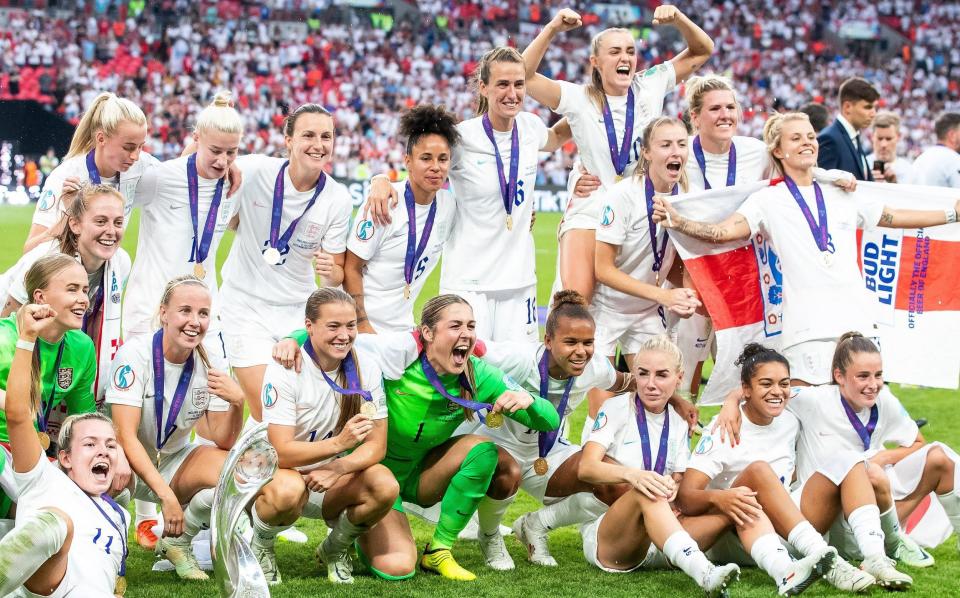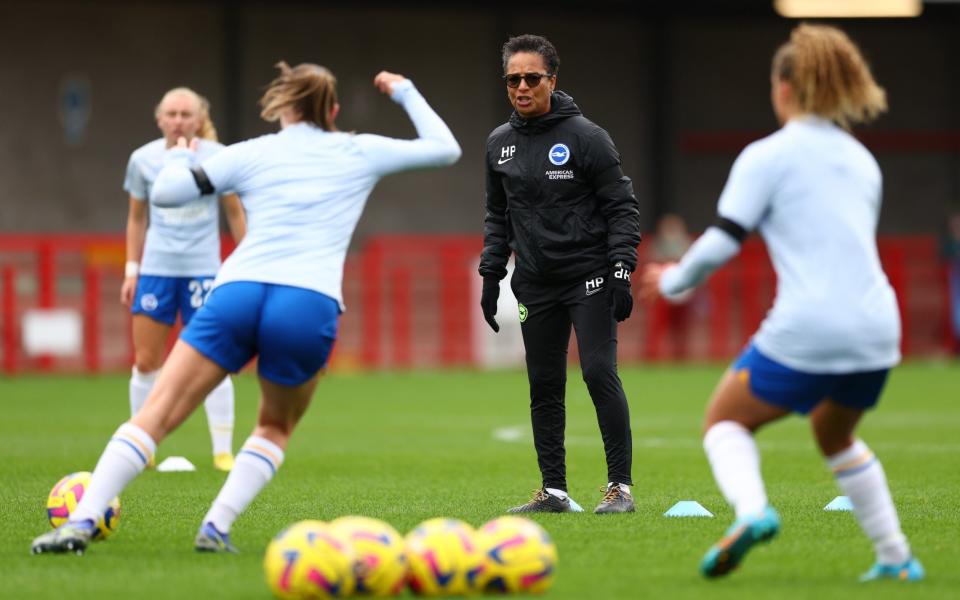Grass-roots football craves more than a Euro boost

England’s Euros triumph at Wembley this summer provided a once-in-a generation chance to grow the women’s game. Four months on, the signs are that interest in women’s and girls’ football is continuing to soar, amid a flurry of record attendances across the pyramid. However, scratch beneath the surface and it is clear more needs to be done, with many issues still to be resolved, not least around facilities and accessibility.
As the Government embarks on a review of the entire women’s game, chaired by England icon Karen Carney, we ask how the game can make the most of the surge in popularity.
Attendances
Women’s Super League crowds have soared to an average of 6,227, including a new WSL-best turnout of 47,367 for September’s north London derby. On Sunday, Sheffield United obliterated the record for the Women’s Championship, the second tier, with 11,137 at Bramall Lane.
Kelly Chambers, manager of WSL club Reading, who play their home fixtures at the Select Car Leasing Stadium, which they share with Reading’s men, said: “All of us as clubs and the FA knew the biggest thing we wanted to try and change this year was getting [more] fans in the door and trying to build that fan base. It needs to keep growing.”
Two-thirds of top-flight teams are averaging more than 3,400 fans this term, and Arsenal have averaged nearly 24,000, thanks to playing two league games at the Emirates Stadium.
Speaking after her side’s loss to Chelsea in front of 38,350 at Stamford Bridge on Sunday, Tottehnam manager Rehanne Skinner said: “It’s great to have these one-off kind of hits but I think the most important thing is that everybody’s average attendance goes up, so still there’s a lot of work to do.”
After removing the “big-stadium” matches, the WSL is averaging 2,770 this season, above last season’s figure, which was below 2,000. Chelsea manager Emma Hayes – who says women’s football tickets are “too cheap” – believes WSL clubs are “all outgrowing our small stadiums”, with the 46-year-old adding that she would like to see teams playing between eight and 12 games per year at their men’s team’s home.
Lower-level facilities
It is not just at the elite level where facilities are a key part of the discussion about how to grow the game. For some, access to a regular pitch of any kind is hard.
Bex Francis-Jones, a former captain of Manchester United Women, knows that feeling well. She is involved in the heartbeat of the grass-roots level, as both player and chairperson at Northwich Vixens LFC. The club are run entirely by volunteers – with even former Wales international Dean Saunders among those to have offered coaching services. The Cheshire club play in the North West Women’s Regional League Division One South, the sixth tier of the pyramid. Players pay to play – £20 per month, as well as a £30 signing-on-fee – but have their kit provided, thanks to local sponsors.
“We’re always wanting to progress, we’re just struggling to grow any bigger because of a lack of facilities,” Francis-Jones says. “In Northwich, there aren’t enough facilities for the teams.”
Francis-Jones has been the club’s chair for around 10 years, and says extra interest since the Euros has enabled a new Wildcats – an FA participation scheme for five-to-11-year-old girls – group to set up in Northwich, and they have teams at all age groups.
Meanwhile, their first and development teams have pitch-access problems. The Vixens play their home matches in the neighbouring village of Lostock Gralam, sharing the men’s team’s venue, but Francis-Jones says: “It’s a grass pitch and the draining system is diabolical – it’s waterlogged quite often. Then there’s our training pitch – we train on a Wednesday night but only on half a pitch, around 40 players on half a pitch, from 8-10pm.
It’s the only slot we can get, but the development team has 16-to-17-year-olds with college, A levels, and some travelling from Altrincham, and they need to leave by 9pm to get to bed to catch college buses at 6am.” She adds that – together with local men’s side Northwich Victoria – they are “actively looking” for land to build on and talking to the Cheshire FA. She adds: “We’re looking to grow a disability team and a walking football team, but we can’t because we haven’t got the facilities.”
Last year, when launching a new grass-roots strategy, the FA set a target of adding 5,000 pitches by 2024 and it is understood more than 3,000 have been built.
Grass-roots growth
Another concern for many lower-league clubs is the one-up, one-down promotion and relegation system, with more than a dozen coaches from tiers three, four and five saying there are bottlenecks in the pyramid, with teams that want to invest unable to do so without promotion.
Fifth-tier Dulwich Hamlet are hosting Gillingham in the Women’s FA Cup second round on Sunday. Their head coach, Ryan Marvin Dempsey, says they have seen an increase in players contacting them for trials, but wants to see more funding trickling down to the grass roots and believes clubs should be rewarded for their investment. “Reshaping the pyramid needs to happen sooner rather than later to help growth,” he says.
“In our league, there’s only one team that can get promoted and you’ve got us, Millwall, Fulham, Worthing, Dartford that are putting a lot of infrastructure and support in and only one team can go up. It stunts growth. There are lots of ways you could do it. You could have two go up from each region, and then a play-off from the top two teams in the region.” The FA is understood to be reviewing the structure, including promotion and relegation.
Diversity
Arguably the most important area. England named an entirely white squad of 23 for a friendly in 2021, and only around 10-15 per cent of WSL players represent black, Asian and minority ethnic communities compared with about a third in the Premier League. The issue is not just related to playing squads. Following former England manager Hope Powell’s resignation from Brighton, the managers at all 24 clubs across the top two English women’s divisions are white.
Former England and Arsenal striker Ian Wright says: “It’s a systemic problem and we are just dealing with it in incidents. We really need to start dealing with the systemic problem.”
The FA is increasing the number of centres of excellence – now known as “Emerging Talent Centres” – for girls’ football across the country to 70. The previous 30 centres were criticised for being predominantly in rural areas and hard to access from inner cities. The FA has also started an initiative called “Discover My Talent”, aiming to provide opportunities to girls from any communities to join the national pathway, and have had 1,622 referrals of school-age youngsters since July 2021.

There are shoots of growth but challenges remain.
Elsewhere, while big steps remain, shoots of growth are sprouting up around the country as careers in women’s football become more visible and attractive to young people, as Francis-Jones points out. “What the professional status of women’s football has also done is inspire some of our girls to become coaches and referees, because they’re seeing them out there now.”
That comes while on television – according to data released by the Women’s Sport Trust this month – WSL television audiences are 1½ times higher than last season, 42 per cent of new viewers are female and young audiences are rising, too.
That is partly why Tammy Parlour, the Women’s Sport Trust chief executive and co-founder, is optimistic that the game can thrive, but says it must not rest on its laurels. “I definitely feel that the success of the Euros [means] we’re entering this new era, but momentum is not guaranteed, there’s still lots that we need to do to drive progress and make sure we see those lasting changes and have an industry that is fully representative of society.”

 Yahoo Sport
Yahoo Sport 




































































